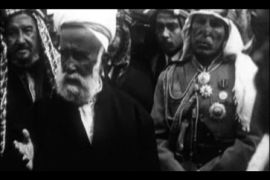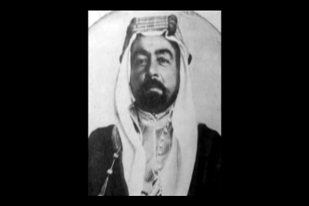Profile: King Abdullah I of Jordan
Abdullah was a moderate leader who dreamed of a greater Arab state.

 |
| King Abdullah I was assassinated on the steps of the al-Aqsa Mosque by a Palestinian gunman in 1951 |
Born to the Hashemite as-Sayyid Hussein bin Ali, the Sharif Hussein of Mecca and close ally to the British, as-Sayyid Abdullah I bin al-Hussein, king of Tansjordan, ruled as a moderate with a pro-Western outlook, which many say was the cause of his assassination.
Abdullah became ruler of the Transjordan territory in 1921 after a British mandate was set, and in 1946, Transjordan received independence and Abdullah became King Abdullah I of Jordan.
Keep reading
list of 4 itemsWhat happens when activists are branded ‘terrorists’ in the Philippines?
Are settler politics running unchecked in Israel?
Post-1948 order ‘at risk of decimation’ amid war in Gaza, Ukraine: Amnesty
Before acquiring rulership of the Transjordan territory from the British, Abdullah and his forces planed to liberate Syria and dislodge the French from Damascus.
Rise to power
When Abdullah was notified of the French forces capturing Damascus at the battle of Maysloun and that his brother Faysal, who was crowned king in 1918, had been expelled, Abdullah moved his forces from Hejaz into Syria.
When Winston Churchill heard of Abdullah’s plans, he invited him to the infamous “tea party” and asked Abdullah not to attack the French, who were Britain’s allies.
Abdullah was convinced to back down, and was rewarded when the British created a protectorate for him, which later became a state, Transjordan.
Moderate ruler
While Abdullah was considered a moderate leader, he and his beliefs were seen as a threat among other Arab leaders in the area.
Abdullah dreamed of a Greater Syria comprising the borders of what was then Transjordan, Syria, Lebanon and the British mandate for Palestine under a Hashemite dynasty with “a throne in Damascus”.
Because of this dream, he was the only Arab leader to accept the 1947 United Nations Partition Plan for Palestine.
Many Arab countries distrusted Abdullah and saw this wish as a threat to the independence of their own countries. They also believed him to be friendly with the idea of the creation of a Jewish state.
With these accusations, Abdullah in return distrusted his fellow Arab leaders.
Abdullah was a moderate in the eyes of the West, even standing for peace with Israel, and would have signed a peace agreement with the Jewish state, were it not for the Arab League’s opposition.
While Abdullah was against military action, he was pressured by neighbouring Arab states in 1948 to join the all-Arab military offensive against the newly created State of Israel, ending with the conclusion of the 1949 Armistice Agreements.
The assassination
|
Did you Know? | ||
|
|
Abdullah’s belief in creating substantial peace followed him to his death, a crucial mark in Jordan’s history.
Robert B. Satloff, the executive director of The Washington Institute for Near East Policy, stated in his book, From Abdullah to Hussein: Jordan in Transition, that: “In one sense, Abdullah’s death clearly marked the end of an era in Jordanian history. After a quarter-century as amir and then another five years as king, Abdullah’s reign was synonymous, not merely coterminous, with Transjordan’s consolidation, autonomy, independence, and ultimately, expansion.
“With great intensity of purpose, Abdullah focused his efforts on the twin objectives of nation and state building, and his significant progress toward them was in the end, his greatest achievement. Transjordan bore his indelible mark, not that of either the Sharifian elite he brought with him north from the Hijaz or the Syrians, Palestinians, and Circassians he enlisted over the years to administer the affairs of state.”
On July 20, 1951, Abdullah was assassinated on the steps of one of the holiest shrines of Islam, the al-Aqsa Mosque in Jerusalem, during Friday prayers, by a Palestinian opposed to Jordan’s tolerance of Israel.
A few days earlier, Riad Bey al-Solh, a former prime minister of Lebanon, had been assassinated in Amman, Jordan, where rumours were circulating that Lebanon and Jordan were discussing peace with Israel.
Abdullah was in Jerusalem to give a eulogy at the funeral of the former Lebanese prime minister and was shot while attending Friday prayers at the steps of the al-Aqsa Mosque.
The gunman fired three deadly bullets into Abdullah’s head and chest. The king’s grandson, Hussein bin Talal (King of Jordan from 1953 to 1999) was at his side.
It is rumoured that a medal that had been pinned to Hussein’s chest at his grandfather’s persistence deflected the bullet and saved his life.
The late Abdullah was succeeded by his son Talal, however, since Talal was mentally ill, Talal’s son – Hussein – became the effective ruler as King Hussein at the age of 17.
